Jeong-Im Hwang and Yoon-Ji Choi1
1 National Academy of Agricultural Science, Rural Development Administration,
Jeollabuk-do, Jeonju, Korea
e-mail: jihwang@korea.kr, veritas96@korea.kr
ABSTRACT
The number of farm households in South Korea decreased from 1,767,000 in 1990 to 1,151,000 in 2012, as did the rate of farm households with successors, 16.4% to 8.9%. Farm succession in the next generation has profound implications for the future structure of the agricultural industry and the procurement of agricultural human resources. Therefore, this study sought to investigate the relevant issues and explore supportive policies using the results of a questionnaire survey of farm operators regarding farm succession plans. It should be noted, however, that this study is the partial result of a study in progress and its survey scope is limited to farm households engaged in the cultivation of paddy rice, food crops, vegetables, and fruits. The survey items are: the presence/absence of a successor, succession plan for the farm households with successors, and support measures for those without successors. Even the farm households with successors revealed difficulties with the implementation of step-by-step succession, thus requiring relevant assistance and educational support for the successors to acquire farming skills. About 28.3% of the farm households without successors had a positive outlook on the transfer of the farm to a third party, suggesting the feasibility of initiating supportive measures for beginning farmers. Additionally, with the rate of willingness for “divisional succession,” irrespective of the presence or absence of a successor, segmentation of agricultural land is anticipated and therefore, countermeasures are necessary.
Keywords: Farm Succession, Farm Transfer, Intergenerational Succession, Korea
Introduction
The family farm sector relies heavily on intergenerational succession (Mishra et al. 2010). However, in South Korea, farming is characterized by an ageing population with a low rate of entry by younger farmers. According to Agricultural Census 1990, the proportion of farm households with successors amounted to 16.4% in 1990; since then, it has been continuously declining (11.0% in 2000 and 8.9% in 2012). While the return to farms and rural areas has been increasing of late, and attracting attention in South Korea, constant effort should be made to set up policies that safeguard the efficient intergenerational succession of the tangible and intangible resources of farming households and improve management structures. Despite this necessity, there is a lack of interest in and support of farm succession in South Korea.
A farm succession support system can be largely categorized into operator-centered, successor-centered, and operator/successor-centered. Most operator-centered systems focus on social security benefits after retirement. However, it is generally acknowledged that these benefits are not large enough to provide security for life after retirement (Kim et al. 2007; Choi 2012). At the same time, government-sponsored agricultural human-resources policy targets family farm successors as well; however, there are hardly any practical measures designed to promote family farm successors (Kang 2008).
Against this background, this study aims to identify the current state of succession planning in farm households and explore supportive policies for the topic, with special emphasis on the importance of succession for family farm-centered Korean agriculture.
DATA
This study presents the results of the first year of research (2013) of a two-year research project. The subjects are farm operators, aged 45 years or older, who mainly cultivate paddy rice, food crops, vegetables, or fruits. The criterion “45 years or older,” which is the standard age for farm succession research, was set based on the age farm operators begin to plan the succession of their adult children. The subjects were selected with the probability proportional to size sampling (PPS) method with respect to the number of family households at the eup-myeon (lower-level administrative districts in South Korea) level for each of the four main crops. Five eup-myeon districts per each crop were identified, and the survey was conducted with about 30 family farms per district. Of a total of 630 questionnaires distributed, 545 questionnaires were returned. After the exclusion of incomplete questionnaires, 539 questionnaires were used for the analysis. Survey items were: the presence/absence of a successor, succession plan of the farming households with successors, and support measures for those without successors.
RESULT
General characteristics of the survey subjects
The most dominant age group of the respondents was 55–64 (34.1%), followed by the group 65–74 (28.2%). Most of them were married (92.8%), most of them were male (90.5%), and the most common education level was high school (41.0%).
Table 1. General characteristics of the survey subjects
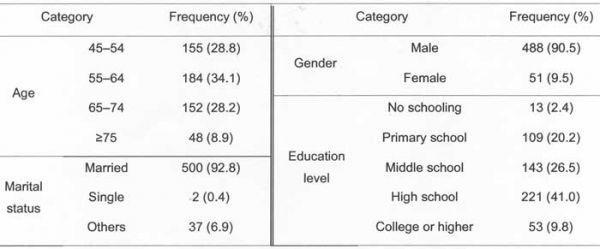
Characteristics of family farm management
The proportion of the main crop cultivated by the respondents, namely, paddy rice, food crops, vegetables, or fruits, ranged between 24.1% and 26.5%. The most frequent size of their farm cultivation area was 3ha or larger (27.5%). Among the respondents, the most frequent level of annual sales reported was in the 9,360–28,079 US$ range (31.9%), followed by 46,800–93,589 US$ (24.5%), and 28,080–46,799 US$ (22.8%). Most households were exclusively engaged in farming (74.2%). However, 16.9% of the households had additional off-farm work that earned higher income than farming, while 8.9% of the households had additional off-farm work that brought in less income than farming. The most frequent number of years of farming experience cited was 30–39 (28.9%), and a high proportion of respondents had farming experience working under their parents (46.8%) or grandparents (31.5%).
Table 2. Characteristics of family farm management
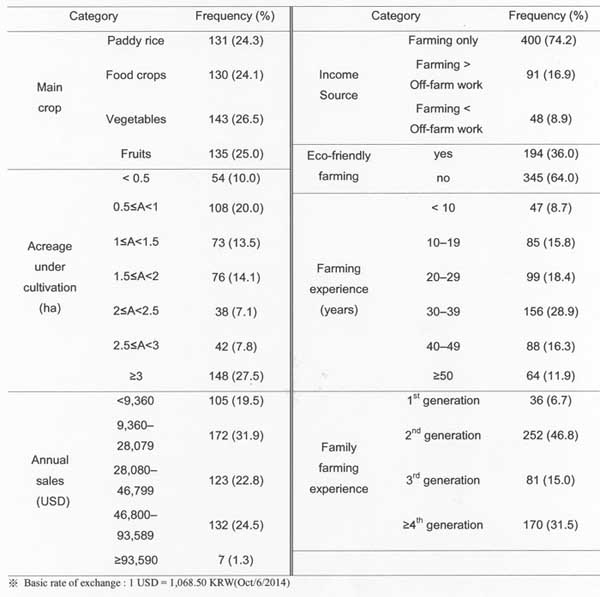
Characteristics of farm succession
Of the respondents, 12.1% indicated that they had designated successors, and 17.1% said that they had potential succession candidates. However, only 16.5% responded affirmatively to the certainty of farm transfer, with the majority (83.5%) choosing uncertainty as an answer. Among households with designated successors, the percentage of those certain of farm transfer was 69.2%, while of the households with succession candidates, 30.4% felt certain of farm transfer.
Table 3. Presence/Absence of successor and probability of farm succession
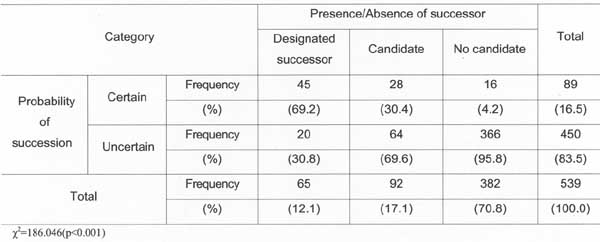
The distribution of the presence/absence of successor by variable did not show any significant differences for acreage under cultivation, annual sales proceeds, income source, and family farm experience. The variables significantly associated with the presence/absence of a successor were: age, crop type, and real estate property size. Many of those with a designated successor or candidate were from farm households whose current operators were aged 75 years or older. This was also the case with households primarily cultivating fruits. Households with real estate areas of 1–2 ha also had a high percentage of designated successors, as was the case for farms of 3 or more ha.
Table 4. Presence/Absence of successor depending on variables
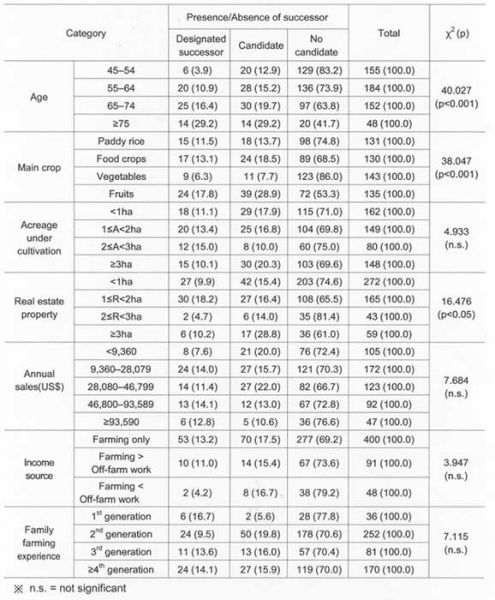
Farm succession planning at the farm households with successors
For farm households with designated successors, the percentage of intra-family succession was 93.6%, of which 67.3% were first-born children. The dominant characteristics of these successors were 98.7% male and 35.7% in their thirties (average age: 37.5 years). The percentage of successors dwelling together (28.0%) was three times lower than those dwelling separately (72.0%). More than half (58.6%) of the successors were engaged in business sectors other than agriculture. About half (49.7%) of the successors participated in agriculture in the form of occasional help at the farms. Among those who graduated high school or had college education, only 13.5% of them studied agriculture (agriculture-related vocational high schools, junior colleges, and faculties). The average number of years of farming experience among the successors was 5.7.
Table 5. Characteristics of farm successors

The most frequent reason for farm transfer to the successor (candidate) was, “to pass the family business on to the next generation” (28.7%), followed by “to comply with the successor’s wish” (18.5%). As for the farm transfer stage, “indefinite concept stage” was the most frequent answer (46.5%). The preferred timing for farm succession was “gradual transfer of management right and farm ownership during the lifetime” (33.1%), rather than “transfer of management right and farm ownership after death” (12.7%). 22.9% were “undecided.”
As for the succession of farmland, the answer “split between the farm successor and other children,” outnumbered “exclusively to the farm successor” (51.6% vs. 35.7%).
Table 6. Farm succession planning

The result of analyzing the age-dependent farm succession stages revealed that the majority of operators under 75 years were in the “indefinite concept stage.” The age group of 75 years or older showed a high response rate of “early farm transfer stage.” As for the successors, the percentage answering “indefinite concept stage” was high, independent of age.
Table 7. Farm succession stages depending on the age of operator and successor
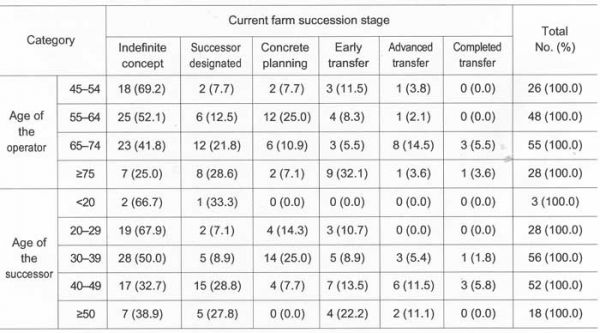
The average age for the expected completion of farm succession was 74.5, and the 75–79 age group showed the densest distribution (16.6%). The dominant answer across all age groups was “unable to foresee the timing for completing the farm succession” (58.0%). Only 1.9% answered that they had already completed farm succession.
Table 8. Timing for completing the farm succession
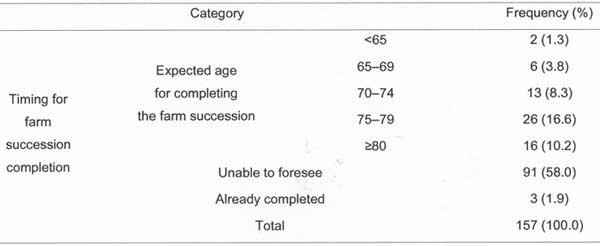
For difficulties encountered or expected, while implementing a farm succession plan, the respondents chose “successor’s knowhow acquisition” most frequently (37.6%). For areas requiring specialist support for the process of farm succession, “business management” was chosen most frequently, followed by “farm successor selection and training” (31.3%).
Table 9. Difficulties encountered while implementing farm succession and required support areas
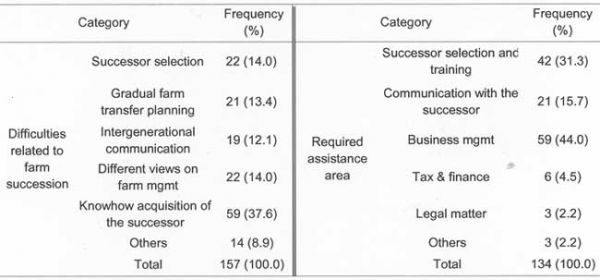
The analysis of the difficulties encountered in each stage of farm succession showed that “successor’s acquisition of agricultural and managerial knowhow” posed the most serious difficulties across the stages. In the early farm succession stage, a relatively large number of respondents also indicated as difficulties, “intergenerational communication about the farm succession plan,” and “adjustment of intergenerational discrepancy in farm management-related opinions.” In regards to difficulties related to crop types, paddy rice cultivators indicated “successor selection” as the most difficult issue, whereas many respondents cultivating the other three crops chose “successor’s acquisition of knowhow” as the most difficult issue.
Table 10. Difficulties related to farm succession by current stage and crop
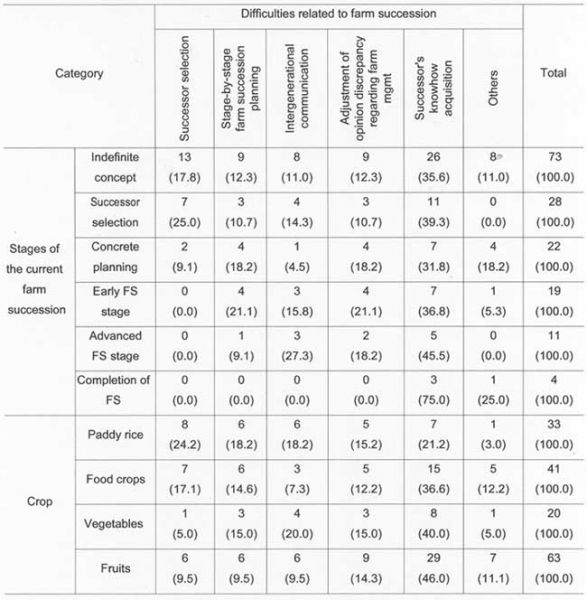
Support measures for farm households without successors
The most frequent reason for not having successors was “unwillingness of the children to accept the succession” (58.4%). In terms of the plan after giving up farming, “distribution among the children” was the most frequent answer (33.2%). The question whether they were ready to transfer the farm infrastructure, along with farming knowhow, to a non-family third party was answered most frequently with “not sure” (44.8%), while 28.3% gave an affirmative answer.
Table 11. Support measure for the farm households without successors
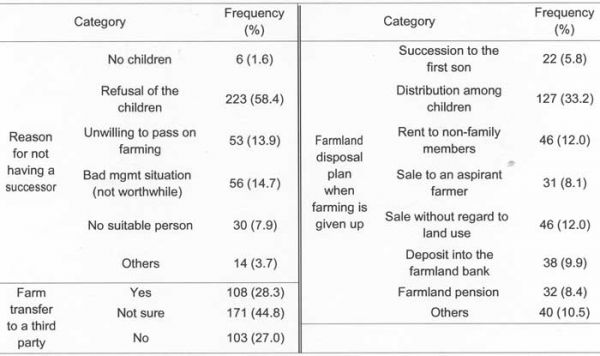
The analysis of the farmland disposal plans by crop indicated that, while farms cultivating paddy rice, food crops, and vegetables preferred the “distribution among the children” (joint inheritance), farms cultivating fruits preferred the sale option. The preference for joint inheritance was high for all estate area sizes, and highest among the <1ha group. The ≥2ha group was especially willing to use the farmland bank, and the 1≤S<2ha group showed a relatively high intention to use the services of farmland pension.
Table 12. Farmland disposal plan by crop and estate size
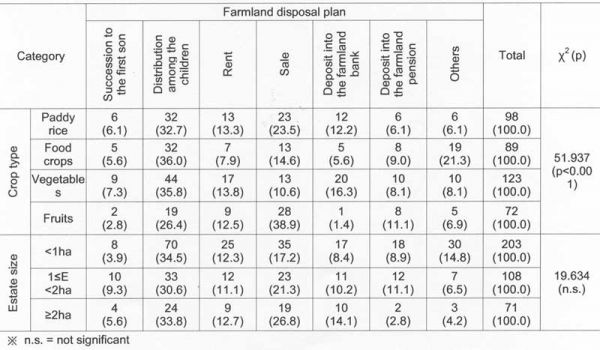
The analysis of the intention of farm succession to a third party in relation to the variables of age, crop, estate size, and sales levels revealed that higher willingness was shown by those under 65, farmed vegetables, with an estate size of 2≤E<3ha, or ≥46,800 US$ in sales.
Table 13. Intention of farm succession to a third party by variable

CONCLUSION
Farming succession has profound implications for the future structure of the agricultural industry and the procurement of agricultural human resources. Therefore, this study sought to investigate the relevant issues and explore supportive policies using the results of a questionnaire survey of farm operators regarding succession plans. The following results were derived from the survey data analysis.
First, support is required in establishing master plans for farm succession from operators to successors. According to the survey results, the critical ages of operators and successors for initiating farm succession planning such as designation and farm succession are ≥65 and ≥40, respectively. In other words, the timeframe for farm succession is expected to be narrow, thus necessitating support to implement it efficiently in a short period of time. As a reference model for a support program, the Resource Center for Farm Establishment of the Canadian province of Quebec is a good example. In this program, a farm household that prepares for farm succession enters into a two- or three-year contract with this support agency, which then provides customized support throughout the stages of feasibility analysis, mediation, and establishment of a strategic plan, as well as providing information and mentoring services. Additionally, there is a model for supporting farm households wishing to proceed with long-term farm succession by setting up a standing counseling system.
Second, systematic educational support is required for successors. In general, the age difference between operators and successors is over 20 years (the average age difference in this survey: 27.2 years), and there is a large discrepancy in education and experience. Moreover, it is difficult for family farms to establish a hierarchy for competence training to draw the line for intergenerational authority transfer and role division. A study (Shunsuke 2012) reported that about 10 years is required for second generation succession of intangible resources. According to the results of the current survey research, most successors have separate dwellings, are engaged in off-farm work, and do not have agricultural education; thus, it is believed they do not to have enough time to ensure the acquisition of farming-related knowhow. Despite continuous farming technology training programs offered by the local agricultural extension agency, there is an urgent need to develop and provide educational programs tailored to the needs of family farm successors.
Third, an assistance policy for farm households without successors should be initiated. With the aggravating global situations related to insufficient farm successors, individual countries have been putting efforts into introducing and implementing systems tailored to local situations to link retired farmers and prospective farmers. Based on the results of this study, which confirmed the general willingness for farm succession to third parties, a Korean non-family farm succession project model should be developed without delay. However, considering the difficulties expected to be encountered in implementing farm succession by matching retired farm operators with non-family farming aspirants, existing examples of this in other advanced countries should be first explored in detail.
Fourth, the fragmentation of farmland ownership should be counteracted. Farmland distribution among multiple successors is an important issue in farm succession. This was apparent in the survey results indicating that in more than half of the households with successors, the successor would own only a part of the farmland, while the rest would be distributed among other children. Additionally, even when the estate area is less than 1ha in size, many of the households without successors wished to split the farmland to distribute it among the children. Although it is not an easy task to address this conflicting intersection of the equality principle, encouraging equal distribution of inherited properties, and the agricultural policy strategic objective, keeping the integral unity of agricultural management, practical support measures are required in compliance with Article 22 of the Farmland Act relating to the prohibition of farmland ownership fragmentation.
REFERENCES
Choi, K-H. 2012. The Present Condition of Farmers’ Preparing for Retirement and Policy Measures. Korea Institute for Health and Social Affairs, Seoul, Korea.
Kang, H-J. 2008. Characteristics of the Farms that Farming Successors Exist and its Policy Implications. Korean Journal of Agricultural Management and Policy 35, 4:829-848.
Kim, J-H., K-H Choi and Y-H Lee. 2007. A Study on the Introduction of Livelihood Stabilization Programs for Elderly Retired Farmers. Korea Rural Economic Institute, Seoul, Korea.
Mishra, A. K., H.S. El-Osta and S. Shaik. 2010. Succession Decisions in U.S. Family Farm Businesses. Journal of Agricultural and Resource Economics 35, 1:133-152.
Shunsuke, Y. et al. 2012. A guidebook for farm succession and fresh start in dairy farms. Sapporo, Japan.
|
Submitted as a country paper for the FFTC-RDA International Seminar on Enhanced Entry of Young Generation into Farming, Oct. 20-24, Jeonju, Korea |


Succession Decisions in Korean Family Farms
Jeong-Im Hwang and Yoon-Ji Choi1
1 National Academy of Agricultural Science, Rural Development Administration,
Jeollabuk-do, Jeonju, Korea
e-mail: jihwang@korea.kr, veritas96@korea.kr
ABSTRACT
The number of farm households in South Korea decreased from 1,767,000 in 1990 to 1,151,000 in 2012, as did the rate of farm households with successors, 16.4% to 8.9%. Farm succession in the next generation has profound implications for the future structure of the agricultural industry and the procurement of agricultural human resources. Therefore, this study sought to investigate the relevant issues and explore supportive policies using the results of a questionnaire survey of farm operators regarding farm succession plans. It should be noted, however, that this study is the partial result of a study in progress and its survey scope is limited to farm households engaged in the cultivation of paddy rice, food crops, vegetables, and fruits. The survey items are: the presence/absence of a successor, succession plan for the farm households with successors, and support measures for those without successors. Even the farm households with successors revealed difficulties with the implementation of step-by-step succession, thus requiring relevant assistance and educational support for the successors to acquire farming skills. About 28.3% of the farm households without successors had a positive outlook on the transfer of the farm to a third party, suggesting the feasibility of initiating supportive measures for beginning farmers. Additionally, with the rate of willingness for “divisional succession,” irrespective of the presence or absence of a successor, segmentation of agricultural land is anticipated and therefore, countermeasures are necessary.
Keywords: Farm Succession, Farm Transfer, Intergenerational Succession, Korea
Introduction
The family farm sector relies heavily on intergenerational succession (Mishra et al. 2010). However, in South Korea, farming is characterized by an ageing population with a low rate of entry by younger farmers. According to Agricultural Census 1990, the proportion of farm households with successors amounted to 16.4% in 1990; since then, it has been continuously declining (11.0% in 2000 and 8.9% in 2012). While the return to farms and rural areas has been increasing of late, and attracting attention in South Korea, constant effort should be made to set up policies that safeguard the efficient intergenerational succession of the tangible and intangible resources of farming households and improve management structures. Despite this necessity, there is a lack of interest in and support of farm succession in South Korea.
A farm succession support system can be largely categorized into operator-centered, successor-centered, and operator/successor-centered. Most operator-centered systems focus on social security benefits after retirement. However, it is generally acknowledged that these benefits are not large enough to provide security for life after retirement (Kim et al. 2007; Choi 2012). At the same time, government-sponsored agricultural human-resources policy targets family farm successors as well; however, there are hardly any practical measures designed to promote family farm successors (Kang 2008).
Against this background, this study aims to identify the current state of succession planning in farm households and explore supportive policies for the topic, with special emphasis on the importance of succession for family farm-centered Korean agriculture.
DATA
This study presents the results of the first year of research (2013) of a two-year research project. The subjects are farm operators, aged 45 years or older, who mainly cultivate paddy rice, food crops, vegetables, or fruits. The criterion “45 years or older,” which is the standard age for farm succession research, was set based on the age farm operators begin to plan the succession of their adult children. The subjects were selected with the probability proportional to size sampling (PPS) method with respect to the number of family households at the eup-myeon (lower-level administrative districts in South Korea) level for each of the four main crops. Five eup-myeon districts per each crop were identified, and the survey was conducted with about 30 family farms per district. Of a total of 630 questionnaires distributed, 545 questionnaires were returned. After the exclusion of incomplete questionnaires, 539 questionnaires were used for the analysis. Survey items were: the presence/absence of a successor, succession plan of the farming households with successors, and support measures for those without successors.
RESULT
General characteristics of the survey subjects
The most dominant age group of the respondents was 55–64 (34.1%), followed by the group 65–74 (28.2%). Most of them were married (92.8%), most of them were male (90.5%), and the most common education level was high school (41.0%).
Table 1. General characteristics of the survey subjects
Characteristics of family farm management
The proportion of the main crop cultivated by the respondents, namely, paddy rice, food crops, vegetables, or fruits, ranged between 24.1% and 26.5%. The most frequent size of their farm cultivation area was 3ha or larger (27.5%). Among the respondents, the most frequent level of annual sales reported was in the 9,360–28,079 US$ range (31.9%), followed by 46,800–93,589 US$ (24.5%), and 28,080–46,799 US$ (22.8%). Most households were exclusively engaged in farming (74.2%). However, 16.9% of the households had additional off-farm work that earned higher income than farming, while 8.9% of the households had additional off-farm work that brought in less income than farming. The most frequent number of years of farming experience cited was 30–39 (28.9%), and a high proportion of respondents had farming experience working under their parents (46.8%) or grandparents (31.5%).
Table 2. Characteristics of family farm management
Characteristics of farm succession
Of the respondents, 12.1% indicated that they had designated successors, and 17.1% said that they had potential succession candidates. However, only 16.5% responded affirmatively to the certainty of farm transfer, with the majority (83.5%) choosing uncertainty as an answer. Among households with designated successors, the percentage of those certain of farm transfer was 69.2%, while of the households with succession candidates, 30.4% felt certain of farm transfer.
Table 3. Presence/Absence of successor and probability of farm succession
The distribution of the presence/absence of successor by variable did not show any significant differences for acreage under cultivation, annual sales proceeds, income source, and family farm experience. The variables significantly associated with the presence/absence of a successor were: age, crop type, and real estate property size. Many of those with a designated successor or candidate were from farm households whose current operators were aged 75 years or older. This was also the case with households primarily cultivating fruits. Households with real estate areas of 1–2 ha also had a high percentage of designated successors, as was the case for farms of 3 or more ha.
Table 4. Presence/Absence of successor depending on variables
Farm succession planning at the farm households with successors
For farm households with designated successors, the percentage of intra-family succession was 93.6%, of which 67.3% were first-born children. The dominant characteristics of these successors were 98.7% male and 35.7% in their thirties (average age: 37.5 years). The percentage of successors dwelling together (28.0%) was three times lower than those dwelling separately (72.0%). More than half (58.6%) of the successors were engaged in business sectors other than agriculture. About half (49.7%) of the successors participated in agriculture in the form of occasional help at the farms. Among those who graduated high school or had college education, only 13.5% of them studied agriculture (agriculture-related vocational high schools, junior colleges, and faculties). The average number of years of farming experience among the successors was 5.7.
Table 5. Characteristics of farm successors
The most frequent reason for farm transfer to the successor (candidate) was, “to pass the family business on to the next generation” (28.7%), followed by “to comply with the successor’s wish” (18.5%). As for the farm transfer stage, “indefinite concept stage” was the most frequent answer (46.5%). The preferred timing for farm succession was “gradual transfer of management right and farm ownership during the lifetime” (33.1%), rather than “transfer of management right and farm ownership after death” (12.7%). 22.9% were “undecided.”
As for the succession of farmland, the answer “split between the farm successor and other children,” outnumbered “exclusively to the farm successor” (51.6% vs. 35.7%).
Table 6. Farm succession planning
The result of analyzing the age-dependent farm succession stages revealed that the majority of operators under 75 years were in the “indefinite concept stage.” The age group of 75 years or older showed a high response rate of “early farm transfer stage.” As for the successors, the percentage answering “indefinite concept stage” was high, independent of age.
Table 7. Farm succession stages depending on the age of operator and successor
The average age for the expected completion of farm succession was 74.5, and the 75–79 age group showed the densest distribution (16.6%). The dominant answer across all age groups was “unable to foresee the timing for completing the farm succession” (58.0%). Only 1.9% answered that they had already completed farm succession.
Table 8. Timing for completing the farm succession
For difficulties encountered or expected, while implementing a farm succession plan, the respondents chose “successor’s knowhow acquisition” most frequently (37.6%). For areas requiring specialist support for the process of farm succession, “business management” was chosen most frequently, followed by “farm successor selection and training” (31.3%).
Table 9. Difficulties encountered while implementing farm succession and required support areas
The analysis of the difficulties encountered in each stage of farm succession showed that “successor’s acquisition of agricultural and managerial knowhow” posed the most serious difficulties across the stages. In the early farm succession stage, a relatively large number of respondents also indicated as difficulties, “intergenerational communication about the farm succession plan,” and “adjustment of intergenerational discrepancy in farm management-related opinions.” In regards to difficulties related to crop types, paddy rice cultivators indicated “successor selection” as the most difficult issue, whereas many respondents cultivating the other three crops chose “successor’s acquisition of knowhow” as the most difficult issue.
Table 10. Difficulties related to farm succession by current stage and crop
Support measures for farm households without successors
The most frequent reason for not having successors was “unwillingness of the children to accept the succession” (58.4%). In terms of the plan after giving up farming, “distribution among the children” was the most frequent answer (33.2%). The question whether they were ready to transfer the farm infrastructure, along with farming knowhow, to a non-family third party was answered most frequently with “not sure” (44.8%), while 28.3% gave an affirmative answer.
Table 11. Support measure for the farm households without successors
The analysis of the farmland disposal plans by crop indicated that, while farms cultivating paddy rice, food crops, and vegetables preferred the “distribution among the children” (joint inheritance), farms cultivating fruits preferred the sale option. The preference for joint inheritance was high for all estate area sizes, and highest among the <1ha group. The ≥2ha group was especially willing to use the farmland bank, and the 1≤S<2ha group showed a relatively high intention to use the services of farmland pension.
Table 12. Farmland disposal plan by crop and estate size
The analysis of the intention of farm succession to a third party in relation to the variables of age, crop, estate size, and sales levels revealed that higher willingness was shown by those under 65, farmed vegetables, with an estate size of 2≤E<3ha, or ≥46,800 US$ in sales.
Table 13. Intention of farm succession to a third party by variable
CONCLUSION
Farming succession has profound implications for the future structure of the agricultural industry and the procurement of agricultural human resources. Therefore, this study sought to investigate the relevant issues and explore supportive policies using the results of a questionnaire survey of farm operators regarding succession plans. The following results were derived from the survey data analysis.
First, support is required in establishing master plans for farm succession from operators to successors. According to the survey results, the critical ages of operators and successors for initiating farm succession planning such as designation and farm succession are ≥65 and ≥40, respectively. In other words, the timeframe for farm succession is expected to be narrow, thus necessitating support to implement it efficiently in a short period of time. As a reference model for a support program, the Resource Center for Farm Establishment of the Canadian province of Quebec is a good example. In this program, a farm household that prepares for farm succession enters into a two- or three-year contract with this support agency, which then provides customized support throughout the stages of feasibility analysis, mediation, and establishment of a strategic plan, as well as providing information and mentoring services. Additionally, there is a model for supporting farm households wishing to proceed with long-term farm succession by setting up a standing counseling system.
Second, systematic educational support is required for successors. In general, the age difference between operators and successors is over 20 years (the average age difference in this survey: 27.2 years), and there is a large discrepancy in education and experience. Moreover, it is difficult for family farms to establish a hierarchy for competence training to draw the line for intergenerational authority transfer and role division. A study (Shunsuke 2012) reported that about 10 years is required for second generation succession of intangible resources. According to the results of the current survey research, most successors have separate dwellings, are engaged in off-farm work, and do not have agricultural education; thus, it is believed they do not to have enough time to ensure the acquisition of farming-related knowhow. Despite continuous farming technology training programs offered by the local agricultural extension agency, there is an urgent need to develop and provide educational programs tailored to the needs of family farm successors.
Third, an assistance policy for farm households without successors should be initiated. With the aggravating global situations related to insufficient farm successors, individual countries have been putting efforts into introducing and implementing systems tailored to local situations to link retired farmers and prospective farmers. Based on the results of this study, which confirmed the general willingness for farm succession to third parties, a Korean non-family farm succession project model should be developed without delay. However, considering the difficulties expected to be encountered in implementing farm succession by matching retired farm operators with non-family farming aspirants, existing examples of this in other advanced countries should be first explored in detail.
Fourth, the fragmentation of farmland ownership should be counteracted. Farmland distribution among multiple successors is an important issue in farm succession. This was apparent in the survey results indicating that in more than half of the households with successors, the successor would own only a part of the farmland, while the rest would be distributed among other children. Additionally, even when the estate area is less than 1ha in size, many of the households without successors wished to split the farmland to distribute it among the children. Although it is not an easy task to address this conflicting intersection of the equality principle, encouraging equal distribution of inherited properties, and the agricultural policy strategic objective, keeping the integral unity of agricultural management, practical support measures are required in compliance with Article 22 of the Farmland Act relating to the prohibition of farmland ownership fragmentation.
REFERENCES
Choi, K-H. 2012. The Present Condition of Farmers’ Preparing for Retirement and Policy Measures. Korea Institute for Health and Social Affairs, Seoul, Korea.
Kang, H-J. 2008. Characteristics of the Farms that Farming Successors Exist and its Policy Implications. Korean Journal of Agricultural Management and Policy 35, 4:829-848.
Kim, J-H., K-H Choi and Y-H Lee. 2007. A Study on the Introduction of Livelihood Stabilization Programs for Elderly Retired Farmers. Korea Rural Economic Institute, Seoul, Korea.
Mishra, A. K., H.S. El-Osta and S. Shaik. 2010. Succession Decisions in U.S. Family Farm Businesses. Journal of Agricultural and Resource Economics 35, 1:133-152.
Shunsuke, Y. et al. 2012. A guidebook for farm succession and fresh start in dairy farms. Sapporo, Japan.